Polyvinyl Butyral (PVB) interlayer film is a crucial component in laminated glass, widely used in automotive, architectural, and safety applications. The thickness of the PVB interlayer film plays a significant role in determining the performance characteristics of the laminated glass. This article explores how the thickness of PVB interlayer film impacts its performance, providing valuable insights for manufacturers and consumers alike.
What is PVB Interlayer Film?
PVB interlayer film is a resin-based film that is sandwiched between layers of glass to create laminated glass. This interlayer provides several benefits, including enhanced safety, improved sound insulation, and increased UV protection. The thickness of the PVB film can vary, and this variation can significantly affect the performance of the laminated glass.
Impact of PVB Interlayer Film Thickness on Performance
1. Safety and Security
The primary function of PVB interlayer film is to hold the glass layers together in the event of breakage. Thicker PVB films provide better adhesion and strength, ensuring that the glass fragments remain bonded to the interlayer, reducing the risk of injury from flying shards. This makes thicker PVB interlayers ideal for applications requiring high safety standards, such as automotive windshields and security glazing.
2. Sound Insulation
One of the key benefits of using PVB interlayer film in laminated glass is its ability to dampen sound. Thicker PVB films offer superior sound insulation properties by absorbing and dissipating sound waves more effectively. This is particularly beneficial in environments where noise reduction is critical, such as in residential buildings near busy roads or airports.
3. UV Protection
PVB interlayer films also provide UV protection, preventing harmful ultraviolet rays from penetrating through the glass. Thicker PVB films enhance this protective barrier, offering better protection for interiors and reducing the risk of fading for furnishings and fabrics. This is especially important in architectural applications where prolonged exposure to sunlight can cause significant damage.
4. Thermal Performance
The thickness of the PVB interlayer can influence the thermal performance of laminated glass. Thicker interlayers can improve the insulating properties of the glass, helping to maintain indoor temperatures and reduce energy consumption. This can lead to more energy-efficient buildings and lower heating and cooling costs.
5. Optical Clarity
While thicker PVB films offer numerous benefits, it is essential to balance thickness with optical clarity. Excessive thickness can sometimes lead to a slight reduction in transparency. However, advancements in PVB film technology have minimized this issue, allowing for thicker films that still maintain high levels of clarity.
Choosing the Right Thickness
Selecting the appropriate thickness of PVB interlayer film depends on the specific requirements of the application. For instance, automotive windshields typically use a standard thickness that balances safety and clarity, while architectural applications might require thicker films for enhanced sound insulation and UV protection. Consulting with a supplier or manufacturer can help determine the best thickness for your needs.
Engaging with Your Supplier
To ensure optimal performance, it is crucial to engage with your supplier and discuss your specific requirements. A knowledgeable supplier can provide guidance on the appropriate thickness of PVB interlayer film based on your application and performance needs. Regular communication with your supplier can also lead to better maintenance practices and timely replacements, ensuring your laminated glass performs at its best.
Conclusion
Understanding the impact of PVB interlayer film thickness on performance is essential for making informed decisions in both manufacturing and application. Thicker PVB films offer enhanced safety, sound insulation, UV protection, and thermal performance, making them suitable for a wide range of uses. By choosing the right thickness, you can ensure that your laminated glass meets the highest standards of quality and performance.
Are you ready to explore the benefits of different PVB interlayer film thicknesses for your applications? Contact us at info@sourceglas.com to learn more about how the right PVB film can enhance the performance of your laminated glass.
Post time: Nov-25-2024


